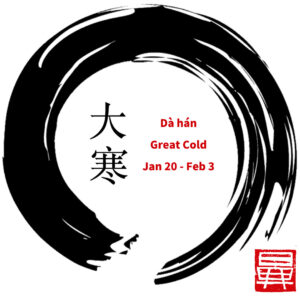
24 Solar Terms or Seasonal Points
The 24 seasonal points, also known as solar terms, form an integral part of the East Asian lunisolar calendar, with roots tracing back to ancient China during the Shang and Zhou dynasties around 1600 BCE. This calendar underwent comprehensive development and integration into the Chinese calendar system during the subsequent Qin and Han dynasties (221 BCE). Spanning over 3000 years, this profound knowledge has entrenched itself as an indispensable aspect of living and cultural heritage.
Within each season, encompassing 3 months (referred to as 3 moons), there exist 6 seasonal points, each lasting approximately 15 days. These points are meticulously adjusted to ensure an even division of the calendar year. The observation of these 24 transitional time periods serves as a detailed record of the changing seasons. Each seasonal point is assigned a name, contributing to a synthesis of nature’s voice by describing various natural phenomena and astronomical events.
The significance of these 24 seasonal points extends beyond mere observation, playing a pivotal role as a guide in diverse aspects of life. They serve as a reference for agricultural production, understanding weather patterns, maintaining health, and participating in ceremonies and rituals. Notably, these seasonal insights are documented in the Tong Shu, the Chinese Almanac.
The 24 Seasonal Points or Solar Terms of TCM
The 24 Seasonal Points or Solar Terms in Traditional Chinese Medicine (TCM)
As the seasons unfold, ushering in shifts in landscape and climate, our bodies and minds resonate with these natural changes. We’ve all felt the ebb and flow that accompanies the transition between seasons—the lengthening or shortening of days, the fluctuations in weather, and the profound impact on plant and animal life.
Various earth-based wisdom systems emphasize the importance of aligning ourselves with this natural rhythm rather than resisting it. Embracing a harmonious existence with the changing seasons becomes a pathway to enhanced well-being.
Exploring the 24 Solar Terms or Seasonal Points
Ancient Chinese observers, attuned to the intricacies of the natural world, crafted a lunisolar calendar— one that harmonizes both the movements of the sun and the moon. In this discussion, we delve into the solar points, representing the complete orbit of the sun. These solar terms intricately divide the calendar into 24 segments, comprising 12 major nodes and 12 minor nodes collectively referred to as Jie Qi or “seasonal points/solar terms.”
It’s worth noting that when aligning this calendar with the Gregorian calendar, slight variations of one or two days may emerge each year. Therefore, one should be mindful of the potential minor differences in solar term dates compared to the Gregorian date on an annual basis.
Each seasonal point spans approximately two weeks, akin to mini-seasons within the broader seasonal tapestry. These solar terms serve as reflections of climatic changes occurring as the sun completes its annual circular journey. Historically, this calendar played a crucial role in supporting agricultural endeavors, and today, it continues to hold significance in guiding daily rituals and routines in China and various East Asian countries.
24 Solar Terms and Chinese Medicine (TCM)
Traditional Chinese Medicine (TCM) underscores the importance of adjusting our behavior in accordance with the external environment to uphold health, vitality, and prevent illness. Thus, the solar terms can serve as markers guiding us in aligning our dietary and lifestyle decisions with the patterns of the natural world.
Share this Page: